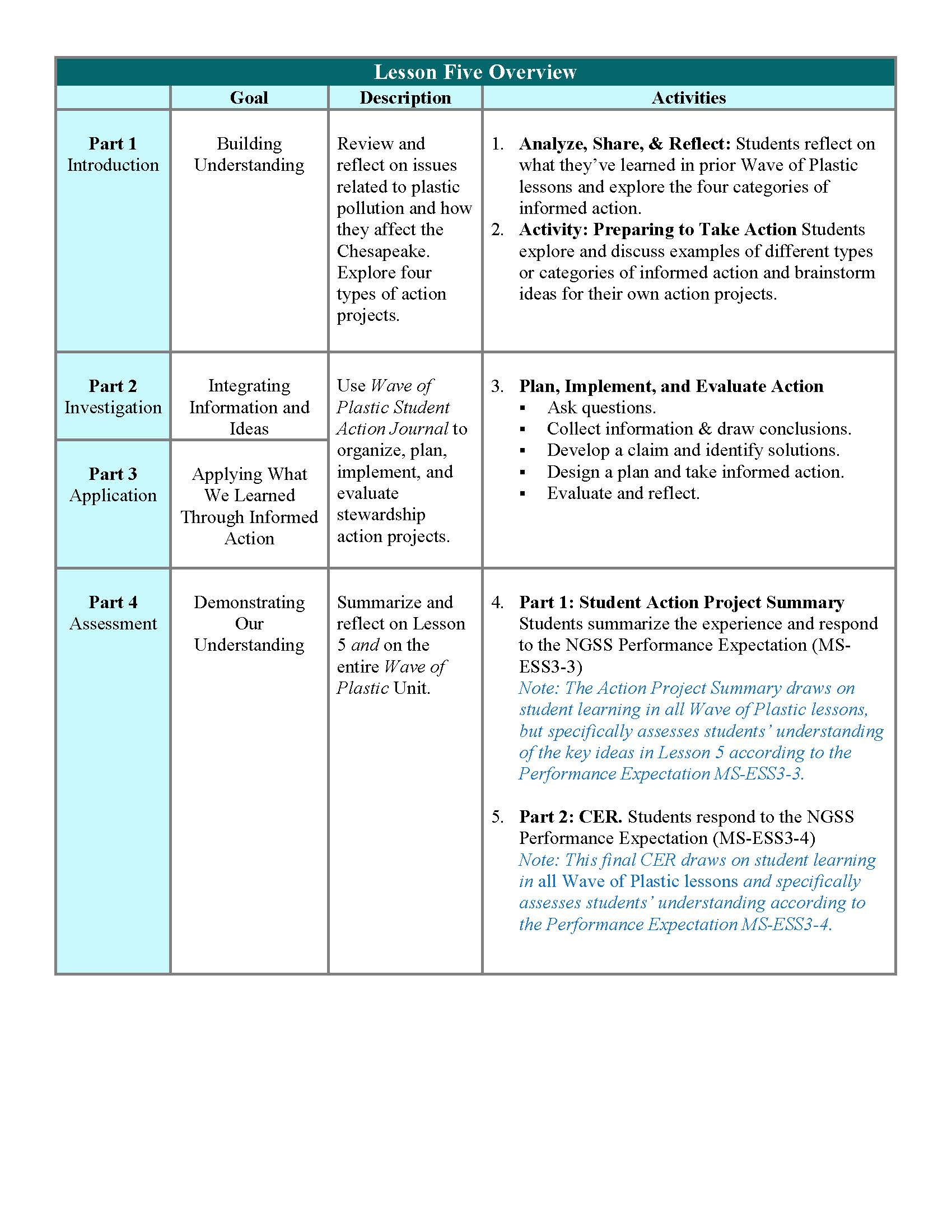Lesson 5: We can make a difference
Download the Lesson 5 Teacher/Facilitator Guide
Download the Lesson 5 Student Workbook
Watch Lesson 5 Video
Activities from Lesson 5 of the Wave of Plastic have been pulled out below for the ease of use with at home education. Please download the complete Teacher/Facilitator Guide and Student Workbook for meaningful instruction assistance and structural support for implementing the complete lesson and/or unit.
Key Ideas
- How do we describe, quantify, and communicate about issues related to plastic waste?
- What is environmental stewardship?
- How are students and other citizens engaging in informed action to address issues of plastic pollution?
- What can we do?

Activity 1-Review & Reflect: Plastic Pollution Issues and Chesapeake Bay
Background
Objectives:
- Ask questions and make observations about how our choices and activities regarding the consumption and disposal of materials contribute to issues of plastic pollution.
Students will:
- Access the following resources: Chesapeake Bay Program video “Bay 101: Restoring the Chesapeake Watershed”, Chesapeake Bay Program Bay 101 Resources, NOAA Stewardship Definitions
- Review and reflect on issues related to plastic pollution and how they affect the Chesapeake.
- Explore stewardship definitions and the four different types of action projects promoted by the Chesapeake Bay Program for Meaningful Watershed Educational Experiences (MWEE): watershed restoration and protection, civic action, community engagement, and everyday choices.
Directions
Step 1- Review and reflect on the resources.
Step 2- Take notes and list any ideas you have about: plastic pollution, its impacts on the Chesapeake Bay, the definition of stewardship, and different action projects you might be able to get involved in or start.
Discussion
Discuss your answers to the following questions:
- How can we describe issues related to plastic waste?
- How can issues related to plastic waste affect the Chesapeake Bay and its watershed?
- What were the actions that we took in the previous Wave of Plastic lessons to address issues of plastic waste?
- What was the intended impact of each action? (What did we hope it would achieve?)
- What was the actual impact of each action?
- How can we classify each action?
- What other types of action are there?
Activity 2-Preparing to Take Action
Background
Objectives:
- Explore ways that we can take informed action to address issues related to plastic pollution.
- Integrate and interpret information presented in different media or formats to develop a coherent understanding of a topic or issue.
Students will:
- Explore actions that others are taking to address issues related to plastic pollution.
- Brainstorm problems they’ve noticed with plastic pollution or the use of plastic products
- Access the following resources: National Geographic Video “Kids Take Action Against Ocean Plastic”, Chesapeake Bay Program Letter “From the House of Commons, London to the Chief Executive of Tesco Plc. requesting the elimination of plastic packaging from brand products”, Less Plastic UK Website and Infographic “Less Plastic: 9 Reasons to Refuse SingleUse Plastic”.
- Download the visual, “Types of Action Projects”
Directions
Step 1-Review key ideas from previous Wave of Plastic lessons and the impacts of actions that the students have previously taken.
Step 2- Review the goal of Lesson 5: Using what you’ve learned about plastic and its effects on the environment, design and implement an action project to minimize the negative impacts of plastic pollution. Monitor the project’s progress and evaluate its success.
Step 3- Review the visual, “Types of Action Projects”. Discuss potential examples of each type of action and if there are examples of actions that could fall into more than one category.
Step 4- Review the resources listed above and try to see if you can locate your own examples of action projects using the internet, noting:
- The specific problem that the action project is intended to address (for example, overuse of single-use plastics, entanglement and ingestion by aquatic animals, etc.)
- The steps that were taken to address the issue
- The impact of the action
- How the action was shared with the broader community
Discuss your answers to the following questions:
- What was the specific problem (or aspect of the problem) that each action is intended to address?
- What steps were taken to address the issue?
- What was the impact of the action? How do we know if they action is successful?
- How is the action being shared with the broader community?
- What are some issues related to plastic pollution that we’ve observed in our community?
- What are some ways we could take action to address them? What impact do we think those actions could have?
Activity 3-Applying What We Learned Through Informed Action
Objectives:
- Use the Wave of Plastic Student Action Journal to plan, implement, and evaluate solutions for addressing issues related to plastic waste in our communities.
Students will:
- Download the Wave of Plastic Student Action Journal
- Use Wave of Plastic Student Action Journal to organize, plan, implement, and evaluate stewardship action projects.
Directions
Step 1- Fill out the Wave of Plastic Student Action Journal.
Discussion
Discuss your answers to the following questions:
- How can we describe issues related to plastic waste?
- How can issues related to plastic waste affect the Chesapeake Bay and its watershed?
- What are some issues related to plastic pollution that we’ve observed in our community?
- What are some ways we could take action to address them? What impact do we think those actions could have?

